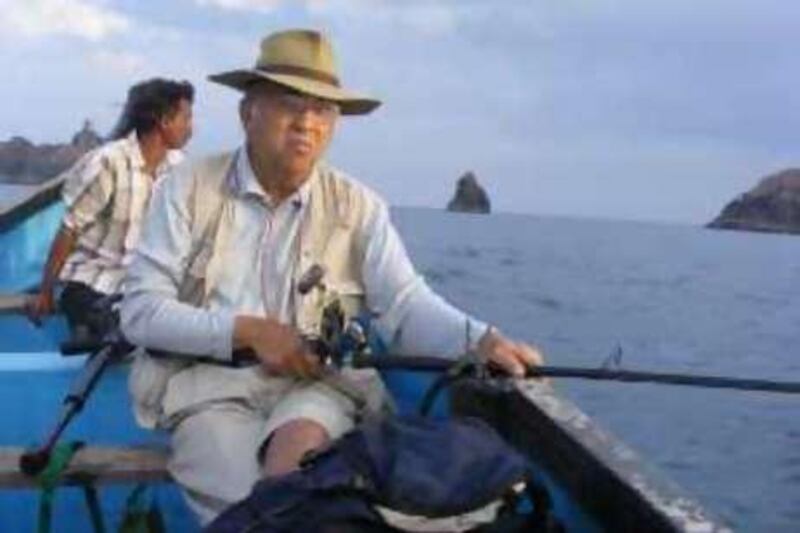In the warm waters off the coast of Maharashtra, S Subramanian goes in search of the Indo-Pacific sailfish.
Like all fishermen, Danny Moses remembers the one that got away. A few years ago, he was angling on the Angria Bank, a huge submerged coral reef off the western coast of India. Around three in the afternoon, when a day at sea is at its most deliciously torpid, Moses' big lure suddenly popped. "The fish bit and then it just kept diving," Moses remembers. "It was just a small reel, so we were a bit scared. We were sure it was a marlin, trying to go deep and throw us off as they usually do."
After a few pregnant minutes, though, the fish modified its battle plan. Rocketing suddenly to the surface, it performed a complete somersault at some distance from the boat; only when it repeated the cartwheel a little closer did Moses recognize it as a sailfish, one of the most elusive, fearsome quarries of the deep-sea angler. "We could see the lure snagged at the corner of its mouth," he says. "It was shaking its head so violently that the rod was whipping about from side to side - thaap! thaap! thaap!"
The sailfish fought Moses every second of the 90 minutes he took to reel it closer to his boat. Then, putting on his gloves, Moses began pulling in the braided shock-leader line, hand over hand, foot by arduous foot. "It was seven or eight feet long, and probably 50 kg in weight. Its fin alone was two-and-a-half feet high," he says. "We were fishing on a catch-and-release basis, so all I needed to do was to touch and tag the fish to claim it as a catch."
But sometimes, Moses sighs, the size of a fish can just freeze you. When the sailfish was three feet from the boat, Moses found himself staring right into its rolling, furious eyes. "He was going gold and purple with rage, and these huge black bands were running down his side," he says. "The sailfish's bill is like a razor - you put your hand out, and you might get it sliced off. That was the dilemma." And in that moment of Hamlet-like indecision, Moses panicked. "I decided not to reach out."
It takes a lot to push Moses into panic. He is a big man with powerful arms and shoulders, and like many Goans, he has been an inveterate angler for most of his life. For the better part of two decades, Moses has run sport-fishing clients out to sea from India's western states of Goa and Maharashtra. When I met him this past October, having heard about his vast experience with game fish, Moses told me, "My son fishes because I fish, and that's how it's always been here." But on that day over the Angria Bank, the sailfish froze Moses. "I've tried to justify it to myself so many times since then," he says. "Maybe at the time, I was still a little green when it came to sailfish. But I flunked. There's no two ways about that."
By the standards of the Indo-Pacific sailfish, or the Istiophorus platypterus, Moses's adversary wasn't even particularly a monster. A really massive sailfish can weigh as much as 100 kg and stretch over three-and-a-half meters from rapier-like bill to muscular tail. On its back, like the eponymous sails of a grand schooner, is a black, ribbed dorsal fin, sometimes taller even than the body's own width. "When you spot one, it's a real sight, particularly in the dark," Moses tells me. "You just see the head and the bill first. Then, under the boat's lights, you can see through the water, which is as clear as glass, and its fin begins to unfold and rise ominously."
All that monstrous bulk can also move frighteningly fast. In the 1920s, a series of experiments attempted to put a number on a sailfish's speed by measuring the length of fishing line it pulled from a reel. The stopwatch clicked into action, and in three seconds the sailfish ran away with 90 m of line. That brings its top clocked speed in the region of 110 km per hour and makes it the fastest fish in the ocean. Approaching its top pace, the sailfish folds its sail down flat into a groove along its back, like a captain stowing his sheets and starting up the outboard motor.
Even more spectacularly, the sailfish can change color in an instant, going from its usual dull gray to a regal mix of shimmering silver, blue, purple and gold. On its skin, cells called melanophores, containing dark deposits of pigments, are able to make themselves transparent. Underneath, like a buried vein of gems, is another layer of cells named iridophores, which break and reflect light into an explosion of iridescent colors. This neat prismatic trick, said Peter Baptista, a fervent angler from Mumbai, explains the local moniker of the sailfish in India: the mor maach, or peacock fish.
Baptista, a grandfatherly man who used to be a corporate executive in New Delhi, retired and returned to Mumbai in 1993 with the intention of spending his days golfing and fishing. "When I came back, I wanted to start angling in the sea. Till then, I'd only fished in rivers," he said. "Everything I'd learned over 40 years in the rivers - none of that held any good in salt water." Soon enough, though, Baptista was regularly yanking marlin, tuna and barracuda out of the sea.
It was Baptista who first told me about the sailfish, and about its uncannily precise annual visit to the Indian coastline. For much of the year, the sailfish is found in deeper seas, or at reefs like the Angria Bank, which is over 100 km from the coast and at least 20 m deep. "They're predator fish, and they hunt like packs of wolves," Moses told me. "The small fish swim in underwater currents, so the sailfish wait on the edge of these currents, dart in, grab their food, and dart back out." With their threatening profiles, the sailfish will often herd sardines into a dense cloud and then batter their prey into submission with their long bills. It's a complex, almost military way to get dinner.
In September, however, as the monsoon's rains recede and smaller fish like the flathead mullet make their way down India's rivers into the sea, the sailfish makes an excursion of 15-20 days into estuarial waters in search of food. Those are possibly its easiest meals of the year. If the oceanic currents are conveyor belts of intermittent, rapidly moving batches of food, the estuaries are groaning buffet tables of mackerel, sardines and mullet.
This year, that 20-day window opened right in the middle of September, on the day that many Hindus ritually immersed their clay idols of the deity Ganesha in the sea. (Baptista always uses festivals for his calculations. "Somehow," he says. "the Hindu calendar is amazingly precise about changes of currents. It's like clockwork.") But out at sea, the weather was still rough, and sporadic gusts of rain were still pounding the western coast. Baptista had agreed to take me on a sailfish expedition, but on the weekend when we'd planned to depart, I flew down to Mumbai from my home in New Delhi only to learn that a new squall had set in. I flew back home, and we waited another impatient week, hoping that the weather would turn before our narrow window closed.
When the skies cleared, we headed down the Konkan Coast of the state of Maharashtra, to a little town between Mumbai and Goa. I'm going to call it Xanadu, because anglers, as a species, seem to be obsessively secretive about the location of their favorite waters, and because Baptista knew from a previous trip that Xanadu's coast was a rich mine for sailfish. "We don't even publish our trip photos on the Indian Angler web site," Baptista said, "because you can figure out where it's been taken from the view in the background." I was told the name, I suspect, on a strict need-to-know basis; if I was to get there, I needed to know.
Baptista discovered Xanadu last year, when he was poring over a Wikimapia image of the coast, looking for promising estuarial waters. It is a chubby finger of land, densely wooded, with a creek on one side and the sea on the other; the finger ends where the creek meets the sea. "We came here last year, but we weren't exactly welcomed by the local fishermen," Baptista said. "We had to work to get friendly with these guys. But we're regulars now."
At false dawn, a little before six in the morning, Baptista, his adult nephews Emil and Yvan Carvalho, and I drove through Xanadu's woods and its clustered hamlets of fishing communities, all wide awake already. Near the mouth of the creek, close to a Hindu temple, two local fishermen named Uttam and Kalidas waited for us with the Vinoba Prasad - a bright blue, 20-foot boat with a fitted outboard motor, powerful enough to take us the 15 km out to sea. Uttam lit a clutch of incense sticks; a kilometer out, he would make an offering to the gods of the sea - a coconut, betel nuts and leaves - and circle it once with the boat before chugging further.
As we left the creek, mullet leaped out of the water around us. "The fish are certainly running," Baptista said. Just the previous evening, Xanadu's fishermen had deployed a net known as a rampon - a semi-circular net, with either end held fast on shore. By just waiting a few hours and then drawing the rampon net in, they had snagged seven tons of pomfret. "They're certainly running," Baptista said again.
Tatters of fog hung over the coast, filtering the dim light so unevenly that I was reminded of one of Turner's grimmer seascapes. There were already other fishing craft in the creek and just outside its mouth; in them, men sat wrapped in shawls, with just a solitary line leading from their hand into the water. They were so still that they might have been asleep; only occasionally, they would jiggle the line to keep their bait moving. Off to the side, one segment of the horizon was a dense sheet of gray. Somewhere, not very far away, it was raining.
Marcel Proust once wrote about the abrupt thrill of a fish breaking the surface of water, comparing it to the flash of a metaphor in prose. The sight of a worthy specimen is breathlessly anticipated; much of the thrill is in its very suddenness. The rest of the time, the art of fishing is really the art of waiting in thin disguise - waiting not only from hour to hour, as we were doing at sea, or from day to day, as with the fisherman Santiago in Ernest Hemingway's The Old Man and the Sea, but even from year to year, as for the annual Indian visitation of the sailfish.
Big-game fishing in India is one of the British Raj's many persistent legacies, although environmental degradation and conservation laws have now threatened the sport itself with extinction. For years, the prize catch in India was the golden mahseer, a gleaming river fish that British anglers used to call the Indian salmon. The mahseer can be huge; in 1870, in a book titled Thirteen Years Amongst the Wild Beasts of India, an Englishman named GP Sanderson claimed to have once caught a 130-pound monster. But the population of the mahseer has now withered away in many Indian rivers, and angling for it is sharply restricted.
Constrained on the rivers, many sport-fishing enthusiasts turned increasingly to India's coast, vying with commercial fishermen for the tuna, shark, marlin, sailfish and barracuda that lay in the waters. "But even at sea, overfishing is becoming a problem," Baptista said. Massive trawlers scrape the bottom of the seabed to pluck every possible fish into their holds, wrecking the ocean's ecology and scooping in worthless fry before the small fish can mature into adults. In such conditions, the post-monsoon blooms of fish become bonanzas, for fishermen as well as predatory fish.
In the Vinoba Prasad, Emil had already bolted black metal stocks to the gunwale and to the boat's benches, to help hold the rods steady. The fishermen then assembled their fiberglass rods, heavy in the hand, with smooth reel locking mechanisms that purred satisfyingly as they let their line go. "In estuaries, with all the underwater rocks, there is a greater danger of abrasion to the line," Baptista had told me earlier. "So we use a really strong microdynamic reel - made of the same stuff they use to make bullet proof vests. You put a finger to that line when a sailfish is dragging it at top speed, and it will just get lopped off."
At the end of the line was a lure known as the Giant Trembler - a silvery fish-shaped object, about four inches long, with twin three-pronged hooks, glinting odd colors in the uncertain light. The lure was filled with ball bearings, Yvan told me. In the water, it would vibrate and make an intriguing enough sound for a predator fish to take a second look at this strange new snack. We were barely on our way when we hooked our first catch. One rod had been loosely resting in its stock, and Yvan was just beginning to cinch it in when it leapt out of his hands; a few seconds earlier, and the rod would have been in the water.
The rod jerked back and forth, and Yvan puffed as he sought to stay in control. "Emil, get the belt around him," Baptista shouted. Emil, scrambling from his seat, picked up a white belt with a large plastic buckle, used by the standing fisherman to brace the rod against his belly as he played the fish (or as the fish played him). "Get the belt on him, Emil," Baptista hollered again. "I'm trying, Uncle, but he's too fat," Emil hollered back. He paid out a few more lengths of belt, looped it right over Yvan's bulky fishing jacket, and pulled it tight. Yvan himself seemed largely unaware of this exchange as he peered into the sea, willing the fish to submit.
It turned out to be a golden trevally, a yellow tropical fish that had been trailing in the boat's wake and that had received a hook in the corner of its mouth for its troubles. The trevally had fought as trevallies usually do - by presenting its flat side to the direction it was being pulled in, to create as much resistance as possible. "A trevally to open your season, Yvan," Emil said. "That's not bad." Yvan shrugged.
We continued to seek more open waters. To the east, the skies were beginning to flare with the first approach of dawn, and the air was tinged with salt and the acrid perfume of diesel. The sea went from inky to dull quicksilver to sparkly satin. Baptista pointed out patches of water that were rippling with acute energy - shoals of sardines, pursued overhead by diving birds. To occupy himself, Emil baited a line with a rubbery fluorescent yellow-and-green lure and threw it into the ocean to attract squid.
We were headed, eventually, to a sprinkling of rocky islets rising out of the sea, the biggest of them sporting a stubby lighthouse that looked abandoned but wasn't and some houses that looked abandoned and were, in fact, abandoned. "Here, there are more rocks under the water, and some of the bait fish tend to hide beneath them," Baptista said. The predator fish often swam these waters, poking under the rocks to rustle their prey out. Gunning the motor down, we began slow, laborious sorties around the islets, the three fishermen hunched over their rods, staring into the sea.
As if it were an honour even to spar with a sailfish, many fishermen tell proud stories of their defeats in the battle with the monster at the end of their line, as Danny Moses did with me. Participating in the extended sailfish mythos is sufficient in itself, and a mythos it has certainly become. In his memoir, The Sailfish and the Sacred Mountain, Will Johnson describes the sailfish as "a Neptunian being unequaled in majesty and evasiveness, a watery version of the Himalayan snow leopard." To actually catch one is closer to a benediction than a feat of skill - a veteran could fish his entire life without even spotting a sailfish, and a rookie could pull one in on his very first trip to sea, as Johnson did in the Florida Keys.
Even a lost battle can be spectacular. When it is snared, the sailfish leaps out of the water and, fully upright, propels itself across the surface solely on the strength of its thrashing tail, just as a dolphin does. The dolphin seems to do it, though, out of some sense of self-conscious cuteness; with the sailfish, it's all outrage and menace. Veteran anglers call it "tailwalking," and they swap stories - often ones that sound, quite literally, incredible - of how a sailfish tailwalked around their boat for an hour or more
So luminous is the prestige inherent in catching a sailfish, not to mention the attendant lifelong bragging rights, that any claim of having landed one can be met with automatic suspicion and doubt. The Sailfish Cup, held in Miami every year, offers a purse of $100,000 to the team that catches and releases the most sailfish over two days, and not unusually, teams must submit video recordings of each catch. What is unusual is the subsequent, very stark stipulation: "All winning teams will be subject to and must pass polygraph testing. Refusal to take the test will result in disqualification? Polygraph tests will include but will not be limited to questions on angling and release procedures and species of fish."
On the Vinoba Prasad, the sun began to beat down more strongly upon our boating party. Uttam steered consistent circles. I thought of breakfast; then, when the water got a little choppier, I tried not to think of breakfast. Every 20 minutes, Emil asked Uttam to slow down, slipped an electronic Fishing Buddy depth finder into the water, and took sonar readouts of the terrain below. "The mackerel are in," Baptista said. "The big fish should be in by now."
A few minutes after he said that, something bit heavily into his lure. Few human movements suggest the rapid transformation of potential energy into kinetic energy more than that of the fisherman who has finally felt a tug on his line. Baptista stood suddenly to attention, pushed his hat back on his head to see better, and began the rocking motion that is so familiar to anglers - lean back and pull on the rod, then lean forward to hurriedly retrieve more reel. Emil and Yvan hastily pulled their lures in and then started to shout incoherent encouragement. Even Uttam, who had hitherto kept himself coolly detached from the success or failure of this expedition, appeared to develop an interest in the contest at hand.
Many meters from the boat, the fish began to struggle for its life. It fought in one spot for a while and then began to swim furiously around the boat, swinging all the way from Baptista's left to his right and forcing him to pivot where he stood. At that distance, there was still no way of knowing what fish it was, but its size and power were on obvious display. It was too late for Baptista to strap on his belt, so he painfully braced the end of the rod against his belly instead. The line whistled a shrill, ragged tune as it cut through the water around us.
For nearly 10 minutes, Baptista and his fish continued their tug of war, but it was slowly becoming apparent that he had succeeded in working his opponent closer to the boat. Emil grabbed a big net and prepared to help pull the fish in. Baptista, sweating now from the heat and the exertion and the fever of the hunt, paused for a moment as the fish approached the prow of the boat, and we all leaned eagerly over the edge to peer into the water. It was, quite unmistakably, a huge grouper.
With its mottled skin and bulbous mouth, the grouper is one of the more ugly residents of the ocean, looking uncannily like a homely boxer with a permanent fat lip. It is also a perfectly respectable catch for sport fishermen. While they aren't very fast fish, they can be large and heavy, diving powerfully into the refuge of rocks in the hope of shredding the line that holds them. Landing a grouper is a victory of brute strength, and it is ordinarily a satisfactory trophy - but not if you've really been after a prize like the sailfish.
Some of the spirit seemed to leak out of the Vinoba Prasad after the grouper was hauled on board. We made a few more revolutions around the lighthouse, and then again around another bloom of rocks nearby. Yvan caught a yellowtail, but this only appeared to depress the party further. After another hour, we headed back towards the coast to trawl the mouth of the creek. Moses had mentioned that sailfish sometimes enter the river system in search of food, and he had told me a story of a particularly greedy one that had swum up the Mandovi River in Goa, where it was caught by a lucky fisherman. But the Xanadu creek showed no signs of any lurking sailfish. Baptista caught two red snappers in shallower waters with minimal excitement, and Yvan snagged a plastic bag.
At half past noon, we called off the great sailfish hunt. When the boat slid into position at a roughly improvised dock, hands reached out to help unload the grouper, and Kalidas squatted at the river's edge to gut the fish immediately. Yvan and Emil began stowing the tackle in the car. Baptista stood silently for a few moments, watching Kalidas at work. Then he shook himself out of his reverie and told me: "They're saying the water is still cold at the lower depths. Maybe that's the reason the sailfish didn't bite." But he didn't seem convinced of it himself. "At least the snapper should make for really good eating," he said, brightening just a little. In return, I could only offer him the fisherman's perpetual, wishful consolation - that the hunt would probably turn out all right next time.
S Subramanian, a New Delhi-based journalist, has written for The New Republic and the Far Eastern Economic Review.






